- Making delicious agnolotti. Photo by Donna Turner Ruhlman.
Saturday I was reminded of the efficiency of using ratios when I wanted to make a crepe and was so moved to post on the subject that I put up crappy photos of the actual crepe I ate while at my desk.
Still with ratios on my mind, and given that my wife has abandoned me for NYC for a few days, I asked for some proper food photography using a ratio—here with pasta, so easy, so good, and the amazing, self-sealing ravioli, referred to at The French Laundry as agnolotti. In fact, agnolotti are three-tipped ravioli reminiscent of an Italian priest’s hat, but where Thomas learned about them, these here were referred to as agnolotti and so that was how Thomas would always refer to them. (The overcaffeinated Italians play incredibly fast and loose with culinary terminology.)
If you want an actual step-by-step of how to make agnolotti, have a look at The French Laundry Cookbook, but the process photos below give a pretty clear picture. Pasta dough, smooth filling, egg wash, and then trimming with the fluted pastry wheel. (Here's a complete post with great slide show on making the pasta dough itself.)
Again, once you have the pasta ratio, you can make pasta using one egg, two, or three, or more. Just weigh them, 2 parts egg, 3 parts AP flour. Neat and clean, too. I do it in a bowl because I find the "well" method to be messy and well, romantic yes, but really unnecessary. (I usually wind up with egg on my shoe.)
These photos show a chicken-herb mousseline filling, but you could do mushrooms, shrimp, cheese, or the French Laundry's sweet potato filling below. Again, I love these things because they’re virtually self-sealing with no air pockets inside. Armed with ratios, virtually any culinary feat is easily accessible.
Pasta Dough Recipe
- 1 egg per person
- all-purpose flour equal to 1.5 x the weight of the egg (or 2 parts egg, 3 parts flour)
- Olive oil to taste (optional)
- Combine flour and egg (and oil if using) and mix and knead until the dough is wonderfully smooth, about 10 minutes. Cover with a towel and let rest 20 minutes to an hour or refrigerated for up to a day wrapped in plastic. Roll out using a pasta roller, pipe in filling, and seal as described in pictures. Cook until done, a few minutes. Serve with browned butter or sauce of your choosing.
I needed only tap on my trusty Ratio app (which Will Turnage and I built, along with design from Leah McCombe, based on the book of that name) to figure the weight of the flour relative to the weight of my egg. (Contrary to what many think, the Ratio app is available for Android devices.)
Sweet Potato Agnolotti with Sage Cream, Brown Butter, and Prosciutto
From the French Laundry Cookbook
Sweet Potato Filling
- 1 ½ pounds sweet potatoes
- 8 tablespoons (4 ounces) unsalted butter
- 2 slices bacon, frozen and cut into small dice
- Pinch of allspice
- Pinch of nutmeg
- Kosher salt, to taste
- Freshly ground black pepper
- Pasta ration for 3 eggs and 4 ounces flour
Sage Cream
- ⅓ cup sage leaves (from about 4 bunches, use the smaller leaves for the fried garnish)
- 1 cup crème fraîche
- 1 cup beurre monté
- Pinch of kosher salt
- Canola oil for deep frying
- 48 tiny sage leaves
- 2 tablespoons unsalted butter
- 4 thin slices prosciutto, cut into fine julienne
For Sweet Potato Filling
- Preheat oven to 350°F/177°C.
- Cut the ends off of the potatoes and wrap the potatoes individually in aluminum foil, dividing up the 4 tablespoons of the butter evenly among them. Bake until they are soft, 1 to 2 hours (the time will vary, depending on the size of the potatoes).
- Unwrap the cooked potatoes and cut a slit lengthwise in the skin of each. Pull the skin away from the potato and discard. Push the potatoes through a potato ricer while they are hot and place in a saucepan.
- Place the diced bacon in a skillet. Cook until it is lightly browned and the fat has been rendered. Transfer the bacon pieces to paper towels to drain briefly, then add them to the potatoes.
- Stir the potatoes over low heat, seasoning to taste with the allspice, nutmeg, salt, and pepper. Mix in the remaining 4 tablespoons of butter. You will have about 1 ⅔ cups filling (enough to fill 48 agnolotti). Refrigerate the filling until chilled, or for unto 2 days, before filling the agnolotti.
- Roll out the dough and fill the agnolotti according to the photos below. You should have approximately 48 agnolotti.
It should be very smooth. Be sure to make it as wide as possible.
Any smooth filling will work, here a chicken-herb mousseline (there's a ratio for mousseline as well!).
Egg wash will help to maintain a good seal.
Press down gently to seal off one agnolotti from another, pressing firmly to make sure you have a pasta to pasta connection on the sides with no filling in between.
I egg wash the tops, so that after they're cut, I can flip them over to finish the little pasta envelope, as in the photo at the top of this post.
To complete the dish:
- For the sage cream, blanch the sage leaves in boiling water for two minutes. Drain, cool in cold water, and drain again. Squeeze the leaves dry.
- Heat the crème fraîche, beurre monté, and salt over low heat until hot; do not boil. Place the sage in a blender and process to chop it. With the motor running, pour the hot cream mixture through the top and blend thoroughly. Strain the cream into a large skillet. Check the seasoning and set aside.
- In a small pot, heat oil for deep frying to 275°F/135°C. Fry the smaller sage leaves briefly, just until they are crisp (their color should not change), and drain on paper towels.
- Place the butter in a skillet over medium heat and cook to a nutty brown color; reduce the heat and keep warm.
- Meanwhile, cook the agnolotti in a large pot of lightly salted boiling water until cooked through, 4 to 5 minutes.
- Drain the cooked agnolotti and mix them gently with the sage cream sauce over low heat. Divide the agnolotti among six serving dishes and drizzle with the browned butter. Scatter some prosciutto over each serving and garnish with the fried sage leaves.
If you liked this post on pasta, check out these other links:
- My recent post on making quiche Lorraine.
- Aki & Alex of Ideas in Food share their one-minute pasta method.
- Chef Taskashi's book on noodles shows an Asian perspective on pastas.
- Try making pumpkin agnolotti with a fig and brandy sauce.
© 2013 Michael Ruhlman. Photo © 2013 Donna Turner-Ruhlman. All rights reserved.


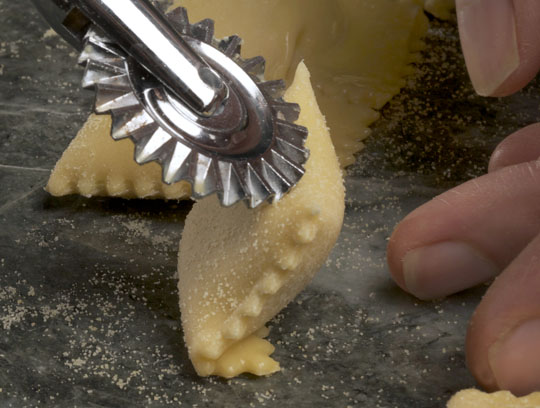
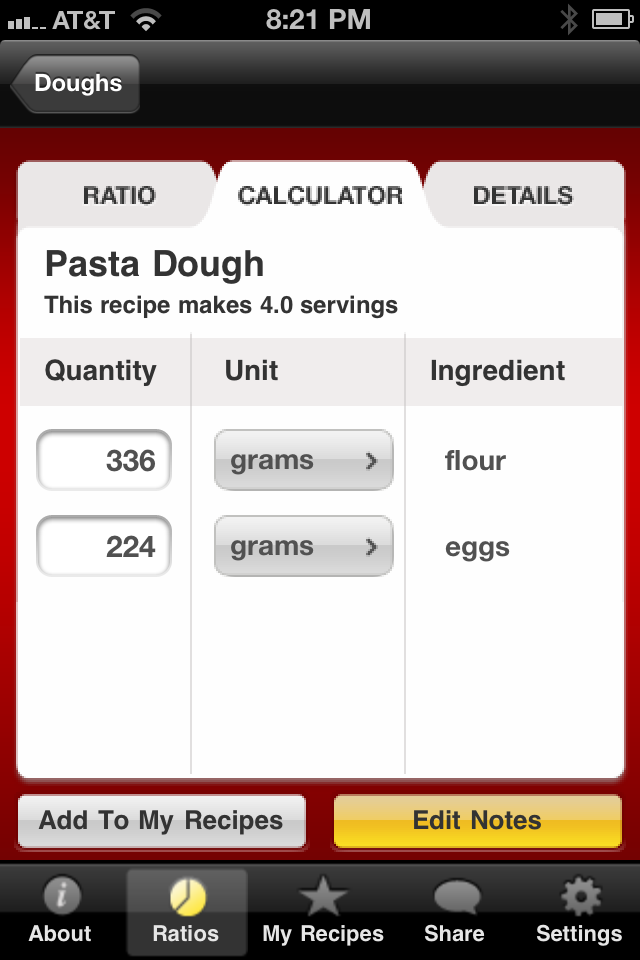
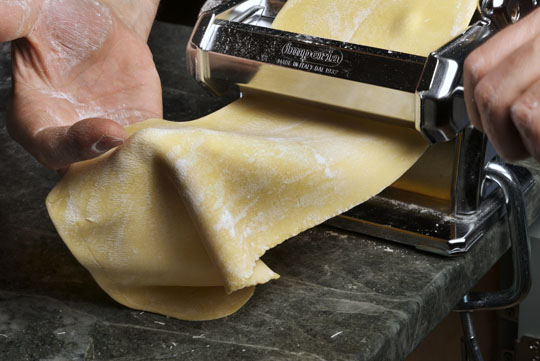

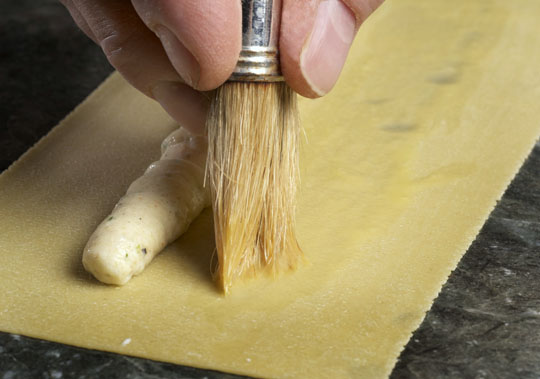
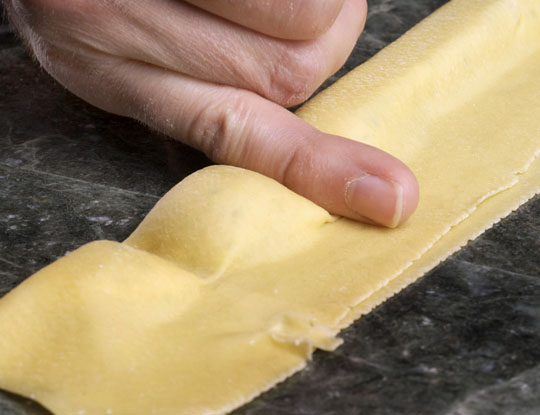
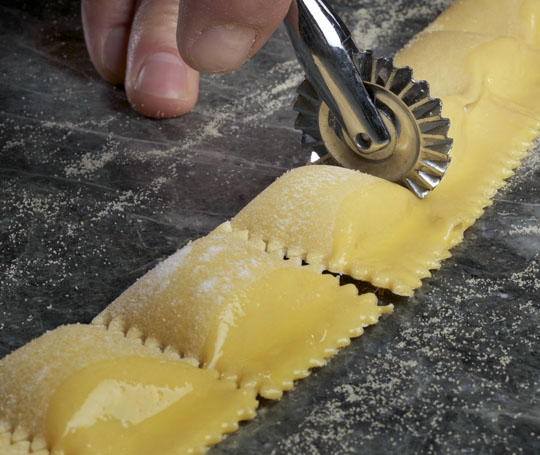
Seems apropos for me to read today...as I had just made it last night! As free-wheeling the Italians are with their terminology between regions, these ravioli (safer with the all-encompassing term) are my favorite version to make because of their ease and bulging pockets of filling relative to pasta encasing it.
One comment on your method though: if after you fold the sheet over the filling and seal it - but before the pinch - you roll the "tube" toward the sealed top edge, just an eighth of a turn or so, then pinch them. If you do that, you end up with more of a pocket (to hold onto that sauce!) at the top of the raviolo than your folded and sealed flap. Buon appetito!
always like the idea of getting more sauce to stick to the pasta!
What do you do with the pasta trimmings can you re-roll them?
I love my copy of Ratio and completely enjoy your blog...even knowing that the two of you have worked together extensively, my favorite part of this post is the mention of Chef Keller as Thomas. 🙂
If we were in the confines of the restaurant, I assure you it would be "Chef," and nothing else.
What brand is that pasta maker? Imperia? Couldn't read the etching. I don't have a Kitchen Aid (yet) and have been looking at a few. Recommendations?
i believe it's an imperia; i haven't found a lot of differences between brands. KA mixers, need at least a 5 qt bowl pref a 6 qt. the professional series is the best but the artisan is most popular at home.
Great post that convinced me to go and purchase the ratios app. Since there's no salt added to the pasta, I'm guessing I should salt the water as I would with dry pasta, is this correct?
I'm sure MR will answer your question, but I can tell you I made pasta the other night using this ratio, which has no salt in it, and I did salt the pasta water. It was perfect.
yes salt the water till it tasted pleasantly seasoned.
I apologize if you have answered this already but do you have any plans to update the Ratio app to take advantage of iPhone 5 or iPad? Thanks!
yes we do have an update planned; finding time is difficult! does the app work on the iphone5?
Are you weighing the eggs with their shells or not?
always weigh them out of the shell (unless you intend on eating the shell, which I don't recommend).
What thickness number should I end at on a pasta roller for filled pastas?
second to last on mine.
This post on agnolotti and the power of ratios is both enlightening and mouthwatering! The detailed steps along with photos make it accessible and encouraging for anyone who wants to try their hand at making this classic Italian pasta at home. The notion of using ratios in cooking, as Michael Ruhlman does here with the pasta dough, opens up a world of culinary possibilities. The recipe itself, whether you go for the sweet potato filling or any other variation, promises a deliciously satisfying meal that's relatively simple to prepare. Plus, the sweet potato agnolotti with sage cream, brown butter, and prosciutto from The French Laundry Cookbook sounds like a must-try dish for any pasta lover. Grazie mille for sharing this culinary adventure with us! 🍝🇮🇹
best pasta recipe
best pasta recipe
What a fantastic exploration of the art and science behind making agnolotti! 🍝 The use of ratios, as emphasized in this post, showcases the efficiency and versatility of pasta making. The step-by-step process, complemented by photos, makes it approachable for home cooks. I appreciate the insight into the French Laundry's terminology and the playful nature of culinary expressions.
The sweet potato agnolotti with sage cream, brown butter, and prosciutto from The French Laundry Cookbook sounds divine. The attention to detail, such as rolling the "tube" to create a pocket for more sauce, adds a valuable touch to the cooking experience. It's delightful to see how a simple ratio of 2 parts egg to 3 parts flour can unlock endless possibilities in the world of pasta. Thank you for sharing this culinary journey, and I'm eager to try my hand at creating these mouthwatering agnolotti! 🌟 #PastaPerfection #CookingRatios #FoodieAdventures
best pasta
best pasta